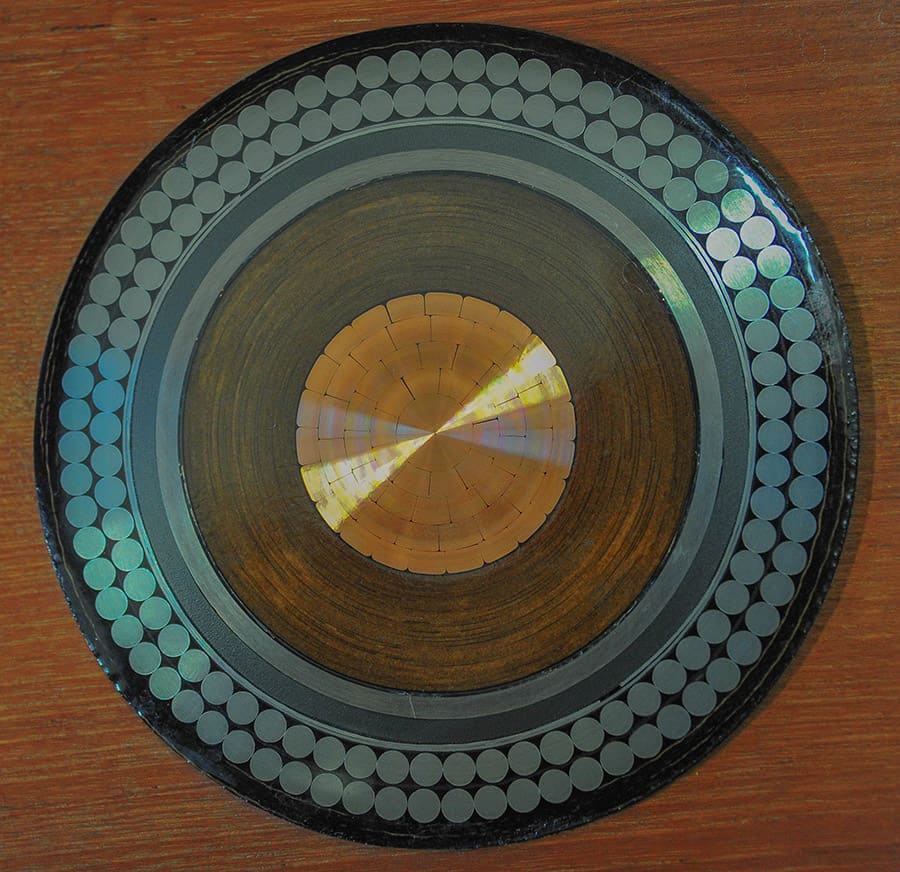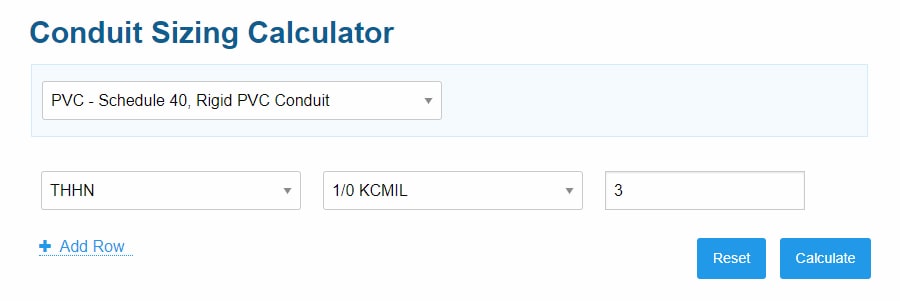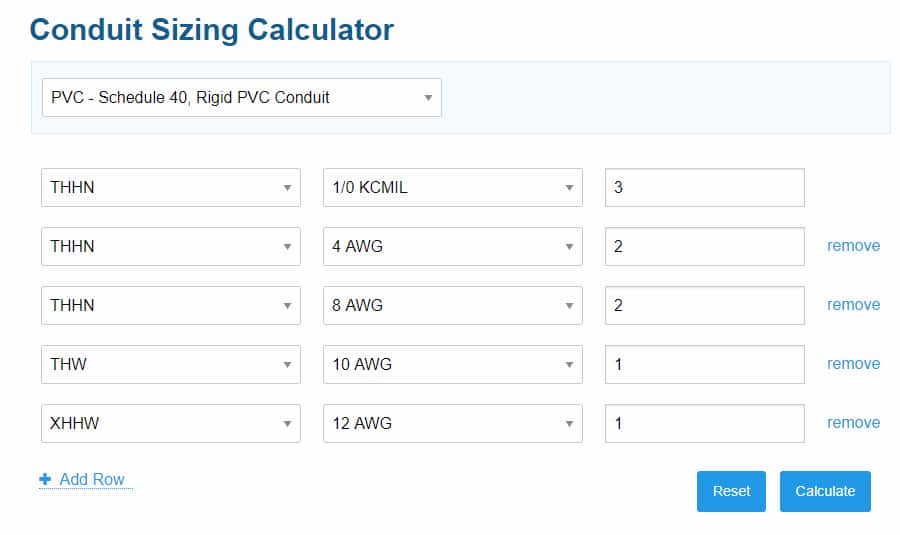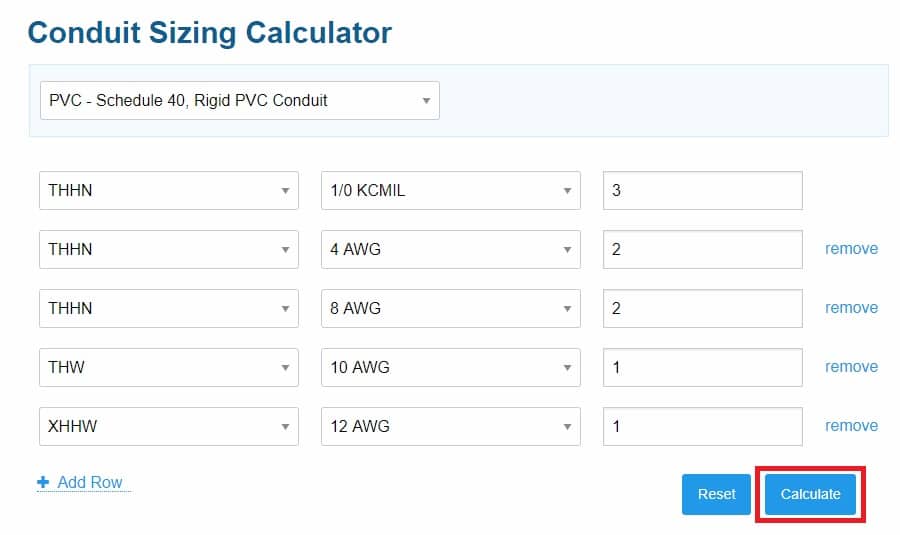How To Calculate Conduit Size For Cables
I'll teach you how to summate conduit size for cables and wires fast and like shooting fish in a barrel. It's a great way to verify your grueling conduit sizing paw calculations.
Besides, convenient for computing conduit sizes on the fly if you're at a job site or standing in Habitation Depot. Our free-to-use conduit sizing computer will practice all the hard work for you lot.
Before nosotros start, information technology'southward of import nosotros acquire the difference between a wire and a cable.
Difference betwixt wires and cables
These two terms people ofttimes misfile together. But in fact, they're quite dissimilar.
I'k going to use both of these terms throughout this article. So, we need to understand the departure.
Wire: is a single conductor. It's usually made of copper or aluminum.
Cable: is a grouping of conductors. In other words, 2 or more than insulated wires make a cable. Remember of several insulated wires wrapped in one jacket.

Conventional way on how to calculate conduit size for cables and wires
For this example, we want to size a Schedule 40 PVC conduit for the below-listed wires. Nosotros'll practise our sizing per the National Electrical Code (NEC).
| Excursion # | Number of wires | Insulation Type | Approximate |
|---|---|---|---|
| 1 | 3 | THHN | 1/0 KCMIL |
| 2 | ii | THHN | iv AWG |
| iii | 2 | THHN | 8 AWG |
| 4 | ane | THW | x AWG |
| 5 | one | XHHW | 12 AWG |
STEP #i: Calculate the wire cross-section area
Using NEC Chapter 9 Table 5, we summate the cross-section expanse of each wire.
To practise this, we match the insulation blazon to the wire gauge in the NEC table.
| Circuit # | Area (in²) | Number of wires | Full surface area (in²) |
|---|---|---|---|
| 1 | 0.1855 | 3 | 0.5565 |
| two | 0.0824 | 2 | 0.1648 |
| three | 0.0366 | two | 0.0732 |
| four | 0.0243 | 1 | 0.0243 |
| 5 | 0.0181 | one | 0.0181 |
Side by side, we add all the wire cross-section areas together: 0.5565 + 0.1648 + 0.0732 + 0.0243 + 0.0181 = 0.8369 in²
STEP #two: Decide the minimum available conduit space
We need to observe how much space our wires can take up inside of a conduit. NEC Chapter 9 Table 1 tells us the following:
- 1 wire: maximum fill is 53% of the total space inside of a conduit
- 2 wires: maximum fill is 31% of the total infinite inside of a conduit
- Over ii wires: maximum fill is forty% of the total space inside of a conduit
In our case, we take a total of 9 wires. And then, per the NEC we can't exceed 40% fill in our conduit.
STEP #iii: Determine the conduit size
Using NEC Chapter 9 Table 1, we choose the conduit size that'll meet the NEC twoscore% fill requirement.
Nosotros apply our total cross-section wire area in the Schedule 40 PVC conduit table.
The NEC table shows a 2-inch conduit can have ane.316 in² of fill while remaining below the 40% requirement. This works since our total wire cross-department area is 0.8459 in².
On the flip side, one conduit size smaller is ane-1/2″. This conduit size can only accept 0.794 in² of fill while remaining below the 40% requirement. Thus, this conduit size falls curt of our total wire cross-department area of 0.8459 in².
The fast and easy way on how to calculate conduit size for cables and wires
We'll now acquire how to use our conduit sizing calculator using our original example. You'll come across how much faster and easier your calculation becomes.
Plus, I'll bear witness y'all how to edit your conduit fill on the wing. You can instantly exam and calculate various conduit fill scenarios.
STEP #1: The conduit sizing calculator
Go to our conduit sizing calculator to get started.

Stride #2: Initial inputs
Select your conduit blazon from the dropdown carte du jour.
Then select your first conductor type and size. Next, input in the conductor count for your first conductor.
In the screenshot beneath, I've entered our Circuit #1 values from our instance. The calculator will and then automatically detect and utilize the appropriate wire cantankerous-department area.

Figurer tip: do you have a custom cablevision or conductor you lot desire to use? If yes, in the "Select Cable / Conductor Type" field, choose "Other / Custom". And then enter your cable or conductor cross-department area in square inches.
Many times, you lot'll need to use a cable or conductor that's not documented in the NEC. And so, you wouldn't find it in our database.

Pace #iii: Enter in your additional wires
Hit "Add Row" for each additional wire blazon yous want to place in your conduit.
In our example, we take 5 full wire types. So, you lot'll need to hit the "Add together Row" button 4 times.

STEP #4: Complete the wire inputs
Repeat STEP #2 for each wire blazon. Enter all your wire data 1 past one.

Calculator tip: if you add an adventitious extra row, don't worry. At the rightmost end of each row, hit the "remove" push button.

STEP #5: Calculate the conduit fill
The easiest part of it all. Striking the "Summate" button to calculate your conduit size.

Calculator tip: even subsequently you hitting "Calculate" you tin go back and alter your inputs. And so hit "Calculate" again to get instantly updated results.

STEP #6: Output results
Curlicue down to see your output results afterwards you lot hit "Calculate". Hither y'all'll find all your calculated conduit and wire information.
The output results include the following fields:
- Full Conductor Area: the calculated total conductor cross-section expanse of all your inputted wires.
- Conduit Size: the calculated minimum conduit size immune past the NEC.
- Total Conduit Area: the total cantankerous-section expanse of your selected conduit size.
- Total Conduit Fill: the percent fill of your selected conduit size per your total wire cross-department area. In our instance, the conduit fill calculates to 25.43%. Much less than the required 40%. In other words, all the wires combined only accept upward 25.43% of the total 2-inch conduit cantankerous-section expanse.

Comparing our output results
We find our full wire cross-department area of 0.8369 in² matches in both calculation methods. Also, the two-inch conduit size we calculated matches too.
In short, our reckoner simplifies the conduit sizing calculation. It'southward a corking way to cheque your hand calculations besides.
Also, it gives you much more than flexibility. You can hands edit your conduit fill in the office, at home, or out on the go. All the while staying compliant with the NEC.
Fifty-fifty more, play around and add or subtract wires. See how your conduit instantly changes in size.
Conclusion
To sum up, if you see any features you lot'd like added just let us know. Also, if y'all see anything in our estimator that needs comeback just requite us a holler.
All in all, nosotros want to make computing conduit sizes for cables and wires easy for anybody.
How do you typically summate conduit size for cables?

Koosha started Engineer Calcs in 2020 to help people amend understand the engineering and construction industry, and to talk over diverse science and engineering-related topics to brand people think. He has been working in the engineering and tech industry in California for over 15 years now and is a licensed professional electrical engineer, and as well has various entrepreneurial pursuits.
Koosha has an all-encompassing background in the design and specification of electrical systems with areas of expertise including power generation, manual, distribution, instrumentation and controls, and water distribution and pumping as well as alternative free energy (wind, solar, geothermal, and storage).
Koosha is nearly interested in engineering innovations, the cosmos, our history and future, sports, and fettle.
How To Calculate Conduit Size For Cables,
Source: https://engineercalcs.com/how-to-calculate-conduit-size-for-cables/
Posted by: robertsonmuddly2001.blogspot.com


0 Response to "How To Calculate Conduit Size For Cables"
Post a Comment